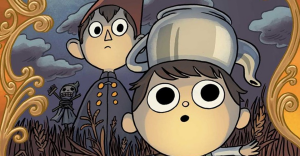What We Do In The Shadows: Every Item Nadja’s Soul Possesses

What We Do In The Shadows’ recurring cast includes a doll that’s been possessed by the mortal soul of the elder vampire Nadja, and when the doll feels neglected by her fellow supernatural housemates, she runs away from home and possesses a variety of familiar items. What We Do In The Shadows started as a mockumentary film about vampires in 2014, and then later grew into an FX series that parodies not only vampires and werewolves, but the entire supernatural world. Out of the series’ main characters, What We Do In The Shadows’ Nadja of Antipaxos is the one who has the closest connection to the world of the unseen.
In What We Do In The Shadows season 2, episode 2, Nadja leads the other vampires in a seance to summon a ghost that’s been haunting their home. It turns out to be the ghost of Nadja’s lover Jeff/Gregor, who has unfinished business with Nadja and Laszlo. The vampires deduce that since they too are dead, then they would have their own ghosts as well, which is confirmed to be true after a second seance, leading the vampires to try and help their respective spirits finish their business on earth. Nadja’s ghost ends up wanting to stay and inhabiting the creepy Nadja doll, which has since become one of the most horrific and beloved What We Do In The Shadows returning characters. Nadja eventually develops a strong connection with the doll, as it is essentially a copy of herself, leading her to treat it like a daughter or sister.
However, in What We Do In The Shadows season 3, episode 7, Nadja and Nandor are occupied with struggling against one another for power over the vampiric council, while Laszlo and Colin are busy with the siren. Everyone completely ignores the doll, including Nadja, which causes the doll to run away from home in a dramatic rage and possess several items along the way. Some of these items are references to traditional tropes in the horror genre.
Nadja’s Soul Possesses A Department Store Mannequin

After realizing that she was ignoring the doll, Nadja deduces that the doll would do exactly what she would do if she felt ignored, which is to run away and make everyone worry about her. While Laszlo and Colin fall in love with Sheila the siren, Nadja, Nandor, and Guillermo track the doll down to a department store. The doll attacks Nandor, who throws it to the ground, leading it to possess a department store mannequin and stumble away. The living mannequin is a classic horror trope that has repeatedly appeared in a variety of media, including the series American Horror Story, the 1987 psychological horror comedy film Mannequin, and the video game Silent Hill: Revelation, to name a few.
Nadja’s Soul Possesses An Angel Statue In A Public Square

The vampires fail to catch up with Nadja’s mortal soul, but follow its presence to a city square, where it possesses the statue of an angel. Statues of angels are a common sight across New York. And along with dolls and mannequins, the moving statue is also a common trope in the horror genre, which is best exemplified by the race of Weeping Angels from the sci-fi series Dr. Who’s Russel T. Davies era. The Weeping Angels were an ancient race of psychopathic time energy vampires, quantum-locked humanoids that can only move when no one is looking at them, trapped in the aged and broken statues of angels. The statue that Nadja’s soul possesses resembles these creatures. Apart from What We Do In The Shadows and Dr. Who, moving or living statues are also present in films like The Haunting of Hill House, Queen of the Damned, and the Harry Potter movies.
Nadja’s Soul Possesses A Giant Inflatable Rat

After Nadja, Nandor, and Guillermo fail to convince Nadja’s soul to return home, it leaves the statue and possesses a nearby giant inflatable rat. Unlike the statue, the mannequin, and the doll, the inflatable rat is not a traditional horror trope, although it could be a subtle reference to the kaiju of the MonsterVerse. Also known as the union rat, the inflatable rat is actually a symbol that protesters use to call attention to workers’ issues. In fact, the rat’s scabby belly is a reference to scabs – non-union workers who threaten the effectiveness of strikes by allowing companies to continue production without addressing workers’ demands. This echoes Nadja’s soul’s own demands of being seen and acknowledged by Nadja. And after Nandor punctures the inflatable rat, Nadja succeeds in begging her mortal soul to finally return to the doll and come back home.
What We Do In The Shadows’ Creepy Nadja Doll

For now, Nadja’s soul is back in the creepy doll and safely at home. But based on the different items that she possessed when she ran away, What We Do In The Shadows season 3, episode 7, reveals that spirits who have unfinished business on earth can indeed be very formidable. As Nadja, Nandor, Laszlo, Colin, and Guillermo encounter increasingly dangerous creatures and situations in the unpredictable What We Do In The Shadows universe, the ability of Nadja’s soul to possess and control seemingly any vessel that represents a living creature is likely to come in handy in the future. This is especially true considering how Baron Afanas and the Sire of all vampires are now under the care of the five main characters, all of whom are likely being closely watched by the Supreme Council of Vampires.
Through the items that Nadja’s doll possesses, What We Do In The Shadows season 3, episode 7, references some of the most famous tropes in the horror genre. Apart from that, the episode also shows how season 3 is exploring the stories of What We Do In The Shadows’ side characters, which is helping to reveal more of the show’s wider supernatural world. Back in What We Do In The Shadows season 2, episode 2, Nadja’s doll started out as just a way for the show to parody the living doll, one of the most overused tropes in horror. But now, her abilities are putting into focus just how diverse and dangerous the What We Do In The Shadows universe truly is.
About The Author

















